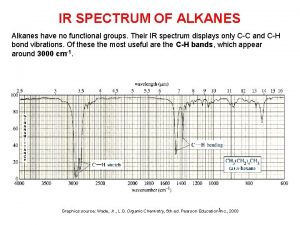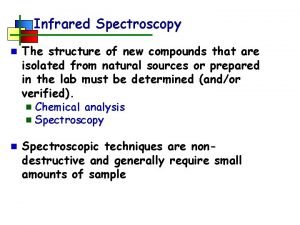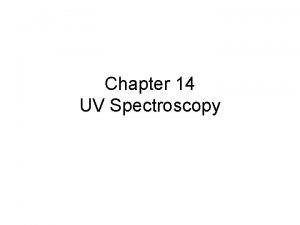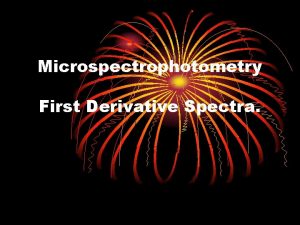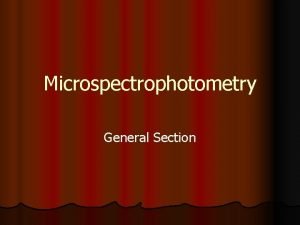Microspectrophotometry First Derivative Spectra First Derivative Spectra are















- Slides: 15

Microspectrophotometry First Derivative Spectra.

First Derivative Spectra are usually compared by overlaying them to see if they match. • If they have multiple points of identification e. g. peaks, troughs, shoulders this is easy to do. • A match can be reported if the peak position and general shape are the same. • If there is little spectral detail e. g. a broad single peak or if there is a subtle difference when spectra are overlaid, the first derivative spectra may be useful to aid comparison.

First Derivative Spectra • Derivative spectra are usually obtained by differentiating the recorded signal with respect to the wavelength as the spectrum is scanned. • The simplest method to produce the first derivative spectrum is by calculating the difference between two points and then smoothing the data before it is differentiated. • The idea of smoothing was first used by Savitzky and Golay. • Modern instruments allow first order derivatives to be generated.

First Derivative Spectra • Example – Red Acrylic Fibre.

First Derivative Spectra • A recent study to determine when the technique would be useful involved the following samples: • Man-made fibres - Red acrylic, Orange polyester, Black polyester, Blue nylon, Blue ‘tiger-tail acrylic, blue polyester. • Natural fibres - Grey lambs wool, yellow cashmere, black cotton, pink wool. • Dye Batch fibre samples – Brown acrylic (10 batches), Red acrylic (7 batches), Red acrylic (9 batches), Navy blue acrylic (10 batches).

First Derivative Spectra • Problems: • If different models of instruments are used to generate spectra the results should be viewed with caution. • Natural fibres exhibit greater variation in absorbance and in the related first derivative spectra. • ‘Tiger-tail’ fibres also show great variation. • Blended samples cause great problems with interpretation. • Examples will follow.






First Derivative Spectra Benefits: • When absorbance spectra are broad and featureless their first derivative spectra provide extra points of comparison. • Subtle differences in the slope of a spectrum can be ‘magnified’ when first derivative spectra are produced. • An example follows.



First Derivative Spectra Conclusion: • First derivative spectra may sometimes be useful but great care should be taken during spectral interpretation to avoid eliminating fibres that originate from the same source.
 Mikael ferm
Mikael ferm Ir spectra numbers
Ir spectra numbers Electro technic products
Electro technic products Correlation diagram in coordination chemistry
Correlation diagram in coordination chemistry Emission line spectra
Emission line spectra Electronic spectra of polyatomic molecules
Electronic spectra of polyatomic molecules Ir spectrum of nitrile
Ir spectrum of nitrile Spectra shropshire
Spectra shropshire Ir spectroscopy table
Ir spectroscopy table Supernova spectra
Supernova spectra Microstate table for p2
Microstate table for p2 Matter and materials grade 12
Matter and materials grade 12 Nitro group ir peak
Nitro group ir peak Mnova stacked spectra
Mnova stacked spectra Conjugation in spectroscopy
Conjugation in spectroscopy Em spectrum frequency
Em spectrum frequency






